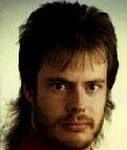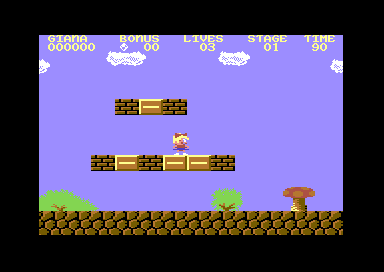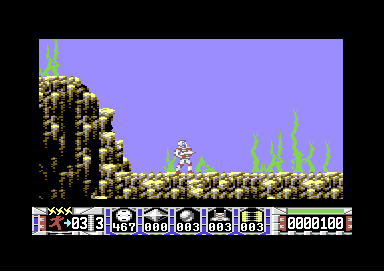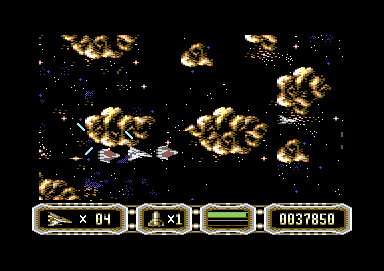Manfred Trenz
| Manfred Trenz | |

| |
| Birth Name: | {{{Birth Name}}} |
| Alias: | The Master |
| Birth Year: | |
| Birthplace: | {{{Birthplace}}} |
| Death Year: | |
| Resting Place: | {{{Resting Place}}} |
| Nationality: | German |
| Employer: |
|
| Occupation: |
|
| Known For: | {{{Known For}}} |
| Q-Link Handle: | {{{Q-Link Handle}}} |
| Social Media: | {{{Social Media}}} |
| Website: | |
| Information: |
|
Manfred Trenz is one of the most famous German game developers. To his credit go the Turrican series, R-Type, Katakis, as well as The Great Giana Sisters.
In 1984, he came in touch with the VC20 at a friend's place kennen, where he produced his own graphics. A short time after, he began to program little programs in Basic on his own C64. Since BASIC on the C64 was slow and not exactly powerful, he began to learn assembler. He drew graphics on the C64, as well, which would later help him to get a foothold in the game industry. At a graphics competion by the magazine 64'er he handed in several images and scored third place.
Shortly after, Rainbow Arts called him. At first, he worked as a freelancer for them. meldete sich wenig später, und Trenz arbeitete zuerst als freier Mitarbeiter. He finally became a permant employee in 1987.
The legend of the name Turrican stemming from an Italian restaurant is not true! Trenz had discovered the name in a phone book of Düsseldorf. The legend of the restaurant, applies to Katakis. However, Katakis is not an Italian name, but a Greek.
Trenz' favourite drink is coffee. His favourite movie is Starship Troopers. In terms of music he likes everything apart from Soul and Blues.
Apart from a message for potential crackers, the tel. number of Rainbow Arts was also hidden in Turrican.
When 900 copies of the Turrican II demo were handed out at a computer fair in Cologne, it caused such a big turmoil that two people where injured.
The title screen of Turrican is a rip-off of the cover of the Manowar album Kings Of Metal.
Initially, the name Giana in the game The Great Giana Sisters was supposed to be written with two N (Gianna), which can also be seen on screenshots of preview versions of the game in various game magazines ((Power Play 2/87, Happy Computer 3/88)). The name was changed retroactively to Giana with only one N. The old name was only remaining on the scrolling title screen.
Trenz' first own project was The Great Giana Sisters, which was almost a perfect copy of Nintendos Super Mario. The game had to been taken off shelves after a few weeks, since Nintendo had successfully sued Rainbow Arts. By this, The Great Giana Sisters became one of the most successful titles for the C64, as the game was vastly spread through pirated copies.
Not only did the clash with Nintendo yield a huge success for the game, but also the good playability. The game had simple controls, elaborate level design and the music composed by Chris Hülsbeck. Mafred Trenz supervised both the graphics and the game and level design.
After The Great Giana Sisters, Trenz began to work on his second project Katakis at Rainbow Arts. Inspired by the sidescrollers R-Type, Nemesis and Darius, Katakis came out as a sidescroller which totally dwarfed tis rival titles. Activision, whoch had released R-Type for other systems, found Katakis looking far too similar to R-Type. Since neither Rainbow arts nor Activision were in interested in a dispute in court, they came to a compromise. Rainbow Arts would program the port fo R-Type to the C64. This port was done by Manfred Trenz, as well.
Yet again influenced by competitors like Metroid and Hawkeye, Trenz developed anothe sidescroller. The run'n'gun Turrican was planned to definitely supass Hawkeye. Turrican was released in 1990, and the game was met with enthusiastic response by both critics and gamers. Trenz had outdone himself with 8-way-scrolling, parallax scrolling, tons of power-ups, mighty weapons and gigantic levels, which were extremely huge for the time. Some levels had a total of 1200 screens with many things to explore and discover, and huge bosses, which were made up of several sprites. There hadn't been a similarly detailed and techinally advanced game on the C64 before. A sequel, Turrican II, already followed in 1991.
The C64 was the main platform for Turrican II, and Manfred Trenz was also responsible for this version. Factor 5 programmed the Amiga port. In order to surpass Turrican, Trenz included shoot'em up levels in the game. The first Turrican had "only" been a run'n'gun.
While Super Turrican for SNES was developed, Trenz worked on Enforcer under the alias The Master. This would be his last game for the C64. Although Enforcer was also very impressive on a technical side, it did not have the success Turrican had. This was prbably due to the fact that it was not published by Rainbow Arts, but by the disk magazine Double Density.
After that, we worked on Rendering Ranger for the SNES, which unfortunatley only managed to come out for Japanese consoles in 1995.
Turrican 3D was supposed to be released in December 1999. Game magazines showed impressive screenshots. Even the hardware specs were released. A PC with 330Mhz, 32Mb RAM and Windows 95/98/NT were required. A company called AllVision was involved in the development. It was a company for architecture, and Trenz has hoping to get an impressive game world from them in terms of architecture. Unfortunatley, development was canceled in 2000. The reasons for this is unknown. Trenz seemingly claimed that AllVision had been greedy for money, which was probably the reason for the discord. Others claimed it was the programmer's or programmers' overconfidence caused a delay in production, which was not acceptable for THQ, the game's publisher. The delay was supposed to have forced AllVision to pay a huge compensation fee to THQ, thus causing them to file for bankruptcy.
After Turrican 3D had failed, two console ports by Trenz were released: Micro Machines V3 for Gameboy Color, in 2000, and CT Special Forces for Playstation in 2003. Trenz was not able to return to the success he had on the C64. For a period of time, he worked for the company Similis on Oberhausen. By a merger with Smash Designs, he founded Denaris Entertainment Software in 2004. There, video games for the handheld consoles Nintendo DS and 3DS are being developed.
Gamography[edit | edit source]



- C64
- The Great Gianna Sisters (Graphiks and level design on the C64, 1987)
- Katakis aka Denaris (1988)
- R-Type (Conversion of the arcade game to the C64, 1988)
- Turrican (1990)
- Turrican II (C64/Amiga, 1991)
- Enforcer (1992)
- Other Systems
- Super Turrican (NES, 1992)
- Rendering Ranger (only released in Japan, on the SNES, former project name was Targa, 1995)
- Turrican 3D (PC, never finished)
- Micro Machines V3 (Conversion of the Playstation and PC game to the GameBoy Color, 2000)
- Katakis 3D (GameBoy Color, developed around 2001, finished , never released)
- Moorhuhn Kart (Conversion of the PC game to the PlayStation, 2002)
- CT Special Forces (Conversion of the Game Boy Advance game to the PlayStation, 2003)
- RTL Skispringen 2004 (various cell phones, 2004)
- Crazy Frog Racer (Game Boy Advance, 2005)
- Paws & Claws: Pet Resort (Game Boy Advance, 2005)
- Paws & Claws: Pet Resort (Conversion of the PC game to the Nintendo DS, 2006)
- Paws & Claws: Pet Vet (Conversion of the PC game to the Game Boy Advance and the Ninteo DS, 2006)
- Dragon's Rock - Drachenfels (Game Boy Advance, 2006)
- Horsez (Game Boy Advance, 2006)
- Meine Tierpension 2 (Conversion of the PC game to the Nintendo DS, 2007)
- WinneToons - Die Legende vom Schatz im Silbersee (Nintendo DS, 2007)
- Paws & Claws: Pet Vet - Healing Hands (Nintendo DS, 2007)
- Ankh: Curse of the Scarab King (Conversion to the Nintendo DS, 2008)
- Germany's Next Topmodel (Conversion to the Nintendo DS, 2008)
- Wickie und die Starken Männer (Nintendo DS, 2009)
- Mein Gestüt: Ein Leben für die Pferde (Conversion to the Nintendo DS, 2009)
Links[edit | edit source]
| Trenz Wikipedia: Manfred Trenz |
- Turrican.Nemmelheim.de Much background information on Turrican and a video with Manfred Trenz
- TurricanForever.de

- DenariSoftware.de Website of Denaris Entertainment Software
- Spieleentwickler.org Log of an interesting chat with Manfred Trenz

- Archive.is Interview with Manfred Trenz
- Kultboy.com Interview with Manfred Trenz in Amiga Joker, issue Juli 1990

- MT-Fanpage.de Fanpage about Manfred Trenz
